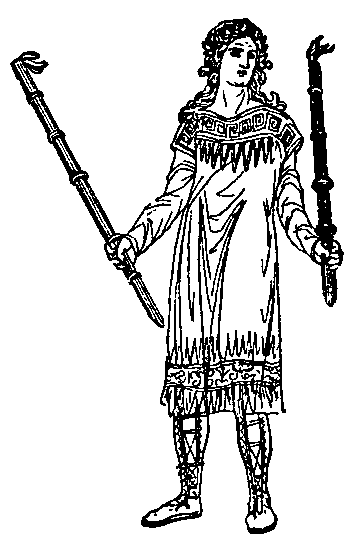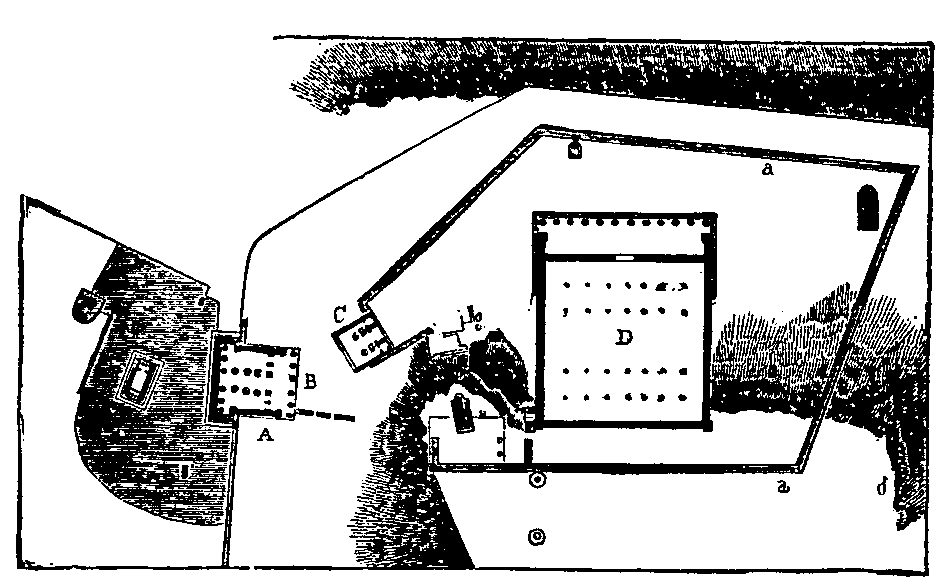|
Dictionary: Search the Dictionary Browse the Dictionary |
|
Timeline: Launch Interactive Timeline |
| Return to Front Page |
| ELEUSINIA | |
Deprecated: Function split() is deprecated in /www/www-ccat/data/classics/myth/php/tools/dictionary.php on line 64 Deprecated: Function split() is deprecated in /www/www-ccat/data/classics/myth/php/tools/dictionary.php on line 64 The two mystic festivals of Demeter and her daughter Persephone (Core) celebrated in Attica. They took their name from the city of Eleusis, twelve miles distant from Athens. This was, from time immemorial, a seat of the worship Of Demeter, instituted, it was said, by the goddess herself after the disappearance of her daughter. (See DEMETER.) The worship of Dionysus was early associated with that of the two goddesses of the earth, for Dionysus was himself a god of fertility, worshipped here under the name of Iakchos, as son of Zeus and Demeter or Persephone. The ritual of the Eleusinian service was supposed to have been ordained by Eumolpus (see EUMOLPUS). The conquest of Eleusis, which took place, according to the story, under king Erechtheus, gave Athens a right to take part in the solemnity, and the lesser of the two festivals was actually celebrated in Athens. Eleusis, however, continued to be the chief seat of the worship, and the highest priesthoods were hereditary in the Eleusinian families of the Eumolpidae and Kerykes. The sanctity which shrouded the Eleusinian mysteries occasioned the foundation of Eleusinia on their model in other Greek cities. But the initiations at Eleusis were always accounted the most sacred and the most efficacious. The events celebrated in the mysteries were the descent of Persephone into the world below, and her return to light and to her mother. The former was celebrated at the greater Eleusinia between autumn and seed-time; the latter in spring at the lesser Eleusinia. The symbolical representation of both events had the same object. This was to excite and strengthen in the minds of the initiated, by means of the story of Persephone, the faith in the continuance of life, and a system of rewards and punishments after death. The right of initiation into the Eleusinian mysteries was in all probability restricted originally to inhabitants of Attica, but it was not long before it was extended to all Greeks. In later times, after their closer connexion with the Greeks, the Romans were also admitted. Barbarians were excluded, and so were all who had been guilty of murder, or any other serious offence. The neophyte was proposed for initiation by an Athenian citizen who had himself been initiated. He was admitted first to the lesser mysteries at the lesser Eleusinia. At this stage the candidates were termed Mystoe, and were allowed to take a limited part in the greater Eleusinia the next autumn. They were not initiated, however, into the greater mysteries, until the greater Eleusinia succeeding these ; and after their initiation were called epoptoe, or seers. The external arrangement of the festival was in the hands of the second archon, or Archon Basileus, who exercised a general superintendence over the whole of the public worship. He was assisted by four overseers (epimeletoe), two of whom were elected from the whole body of citizens, and two from the Eleusinian families of the Eumolpidae and Kerykes.[1] The high-priestly officials, who carried out the liturgical functions at the celebration, were also chosen from these two families. The Hierophantes, or chief priest, belonged to the house of Eumolpus. It was his duty to exhibit to the initiated the mysterious shrines, and probably to lead the performance of the hymns handed down from his ancestors. The Keryx, or herald, was of the house of the Kerykes. He summoned the initiated, in the traditional form of words, to worship, pronouncing for them the form of prayer. The Daduchos or torch-bearer, and the superintendent of the sacrifice, were also important officials. The lesser Eleusinia were celebrated in the month Anthesterion, which corresponded roughly to February. The service was performed at Agrae, a suburb of Athens on the Ilissus. in the temple of Demeter and Core, and accompanied by mystical rites, the nature of which is unknown. It was said to have been founded at the wish of Heracles, who, being a stranger, was excluded by usage from the greater Eleusinia. The great Eleusinia were celebrated in the middle of Boedromion (roughly = September), for a space probably of nine days. The first days were devoted to the preparation for the main festival, bathing in the sea, sacrifices of purification, and the like. On the sixth day, the 20th Boedromion, the immense multitude of mystae, in festal attire and crowned with myrtle, marched in procession along the sacred way to Eleusis, preceded by the image of Iokchos, who gave his name to the celebration. Much time was spent, partly in the performance of acts of devotion at the numerous holy places on the road, partly in merriment and banter; so that it was late in the evening before they arrived at the Telesterion, or house of initiation, at Eleusis. This was a magnificent temple erected by Pericles in place of the ancient temple of Demeter, which had been burnt down in the Persian War. During the following nights various celebrations took place at those spots in Eleusis and its neighbourhood which were hallowed in the story of the goddess. In these were represented the sorrowful searching of the goddess for her lost daughter, and the mother's joy at finding her. The transition from sorrow and fasting to joy and festivity was symbolized by the potion mixed of water, meal, and penny-royal, supposed to have been the first food tasted by Demeter after her reception in Eleusis. It was probably while, these celebrations were going on that the Epoptae, and the Mystae who were called totheir final initiation, took part in the mysteries proper. Mysterious rites were first, it would seem, performed in darkness, which threw the celebrants into a state of painful suspense and expectation. Then, in a dazzling light, and amid great splendour, the Hierophantes showed them certain shrines of the goddess and Iakchos, explaining their meaning; holy songs being meantime performed, partly by himself, partly by choirs with instrumental accompaniment. The climax of the whole was the sacred drama, a representation of the story of the three goddesses in the worlds above and below. The festival was brought to a close by a libation of water from two vessels in the shape of a top (plemochoe). The water was poured in the direction of east and west with mystical formulae. The ancients speak of the revelations made in the mysteries as having a beneficial influence on morality, pointing as they did to reward and punishment after death. They represent them farther as giving comfort in the trials and sufferings of life, and as opening brighter hopes after death. It is certain that there were few citizens of Athens who were not initiated; many who neglected the rite early in life were initiated in old age. For in the popular belief the initiation conferred a claim to the joys promised in the mysteries to the good after death. The Eleusinian mysteries maintained their position for a long time. Among the Romans, men of the highest rank, as, for instance, Hadrian and Marcus Aurelius, deigned to receive the initiation. When the Christian emperor Valentinian put an end to all religious celebrations by night, he excepted the Eleusinia, which continued in existence till they were abolished by Theodosius towards the end of the 4th century A.D. |
|
|
|
|
| Pictures and Media | |
| ELEUSINIAN PRIEST. (Vase from kertch; Gerhard, Ges. Abh., taf. 77.) |

|
| PLAN OF THE TEMPLE ENCLOSURE AT ELEUSIS. A. outer peribolos; aa. inner peribolos; B, greater propylaea; C, lesser propylaea D, Great Temple of the Mysteries, with portico of Philon (183 ft. x 37 1/2 ft.), and Teles-terion, or interior of the temple (178 ft. x 170 ft,), with eight rows of seats, partly hewn out of the rock.- Unedited Antiquities of Attica. chap. i. 5. |

|
|
Copyright 2000-2020 Peter T. Struck. No portion of this site may be copied or reproduced, electronically or otherwise, without the expressed, written consent of the author. |